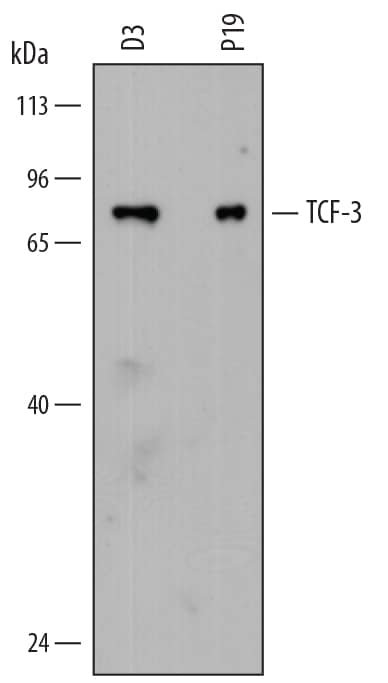Mouse TCF-3/E2A Antibody
R&D Systems, part of Bio-Techne | Catalog # MAB7650

Key Product Details
Species Reactivity
Validated:
Cited:
Applications
Validated:
Cited:
Label
Antibody Source
Product Specifications
Immunogen
Asn33-Arg159
Accession # P15806
Specificity
Clonality
Host
Isotype
Scientific Data Images for Mouse TCF-3/E2A Antibody
Detection of Mouse TCF‑3/E2A by Western Blot.
Western blot shows lysates of D3 mouse embryonic stem cell line and P19 mouse embryonal carcinoma cell line. PVDF membrane was probed with 2 µg/mL of Rat Anti-Mouse TCF-3/E2A Monoclonal Antibody (Catalog # MAB7650) followed by HRP-conjugated Anti-Rat IgG Secondary Antibody (Catalog # HAF005). A specific band was detected for TCF-3/E2A at approximately 75 kDa (as indicated). This experiment was conducted under reducing conditions and using Immunoblot Buffer Group 1.TCF‑3/E2A in Mouse Embryo.
TCF-3/E2A was detected in immersion fixed frozen sections of E9.5 mouse embryo using Rat Anti-Mouse TCF-3/E2A Monoclonal Antibody (Catalog # MAB7650) at 10 µg/mL overnight at 4 °C. Tissue was stained using the NorthernLights™ 557-conjugated Anti-Rat IgG Secondary Antibody (red; Catalog # NL013) and counterstained with DAPI (blue). Specific staining was localized to branchial arch nuclei. View our protocol for Fluorescent IHC Staining of Frozen Tissue Sections.Applications for Mouse TCF-3/E2A Antibody
Immunohistochemistry
Sample:
Immersion fixed frozen sections of mouse embryo (E9.5)
Western Blot
Sample: D3 mouse embryonic stem cell line and P19 mouse embryonal carcinoma cell line
Formulation, Preparation, and Storage
Purification
Reconstitution
Formulation
Shipping
Stability & Storage
- 12 months from date of receipt, -20 to -70 °C as supplied.
- 1 month, 2 to 8 °C under sterile conditions after reconstitution.
- 6 months, -20 to -70 °C under sterile conditions after reconstitution.
Background: TCF-3/E2A
TCF-3 (Transcription factor 3; also Transcription factor A1 and E2A/alpha plus E12/E47) is a 68-75 kDa nuclear class I member of the bHLH family of molecules. It should not be confused with TCF-3, otherwise known as TCF7-L1, an epidermis-associated beta-catenin regulator. TCF-3 is ubiquitously expressed, and generally serves as a transcriptional regulator. It is able to form covalent homodimers, and following phosphorylation, heterodimers with tissue-specific class II bHLH factors, thus impacting the proliferation and differentiation of select cell types. While heterodimers, and possibly homodimers, activate genes by binding to E boxes, heterodimers involving Id proteins are gene repressors. Mouse TCF-3/E12 is 651 amino acids (aa) in length. It contains one Leu-zipper motif (aa 387-422) plus a bHLH domain (aa 544‑604). TCF-3 contains at least three potential Ser phosphorylation sites. There is one alternative splice form that is termed E47 and shows a 69 aa substitution for aa 527-598. This involves the bHLH domain, and it is believed that each splice form has a distinct function(s). Both splice forms (E12 and E47) do occur simultaneously in the same cell type. Over aa 33-159, mouse TCF-3 shares 94% and 75% aa sequence identity with rat and human TCF-3, respectively.
Long Name
Alternate Names
Gene Symbol
UniProt
Additional TCF-3/E2A Products
Product Documents for Mouse TCF-3/E2A Antibody
Product Specific Notices for Mouse TCF-3/E2A Antibody
For research use only

